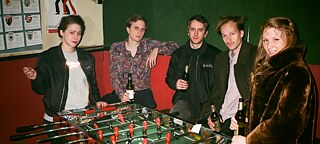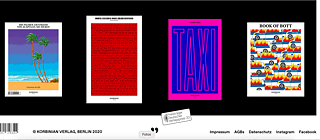Rich Kids of Literature
Provocation und performative aesthetics

Save contemporary literature – that’s what the Berlin collective “Rich Kids of Literature” has pledged to do. This colourful group of authors and students has been causing a riot on the German literature scene since 2016 – with a literature show, an independent publishing house and lots of interest on social media.
By Simon Sahner
Most authors in Germany are not wealthy, in fact it’s often quite the opposite: their financial circumstances are insecure. So at first sight it seemed all the more provocative when a group of young people started to draw attention to themselves on the literary scene five years ago, under the name “Rich Kids of Literature” (RKOL). They were strong willed and full of creative energy just like their namesakes – the “Rich Kids of Internet” – posing and posting on Instagram, but instead of photographing luxury cars and yachts they published photos of strategically placed books and things vaguely associated with literature.
Production on the urban Bohemian scene
To begin with, the loosely connected group – of whom the best-known representatives are publishers and editors Katharina Holzmann, Sascha Ehlert and David Rabolt, as well as authors Charlotte Krafft and Leonhard Hieronymi – was one thing above all: visible. Their productions as a collective on the urban Bohemian scene ranged from the aforementioned Instagram account to a polo shirt and bomber jacket creation featuring the group’s own coat of arms. At first glance the result is a pretty vague image of a literary grouping whose social media presence was based on provocation and attention, and was characterised by a hedonistic aesthetic. Literature simply formed the frame, it first seemed.
It’s only on second glance that you realise that literature was in fact not just being depicted here, but being made as well. Ehlert and Holzmann have been running the magazine Das Wetter (i.e. the weather) since 2013, they founded the Korbinian publishing house in collaboration with Rabolt in 2015, and a reading series organised by the group regularly brings literature onto the stage in Berlin. Now novels and stories are being noticed even outside the confines of their own scene, for example works by Leonhard Hieronymi (In zwangloser Gesellschaft, 2020), Charlotte Krafft (Die Palmen am Strand von Acapulco, sie nicken, 2020) and beyond the group also by Joshua Groß (Flexen in Miami, 2019).

An ultra-Romantic manifesto
Presenting as a group that creates its identity and attracts attention through a performative aesthetic was an established method used by the historical avant-garde to push to the forefront of a complex field like literature. Accordingly the initial reaction from the culture supplements was to suggest a link with the avant-garde movements of the early 20th century. The impression of a new literary trend emerged, which aimed to use “more action, adventure, fun and poetry” to counter an “unofficial ban on ecstatic feeling” imposed by German contemporary literature (Süddeutsche Zeitung).
The fact that this perception was quite intentional as a movement in the spirit of the historical avant-garde is demonstrated by the Ultraromantische Manifest (i.e. the ultra-Romantic manifesto; 2017) by Hieronymi, which, despite not officially being RKOL’s official constitutional document, is in fact positioned and perceived as such. The author aspires to found a “new literary movement to save contemporary German literature” in the form of ultra-Romanticism. The manifesto details 20 points to outline a literary programme that turns out to have an aesthetic combination of science fiction and Romanticism at its heart: “Ultra-Romanticism is a Romantic variation on cyberpunk,” is how it’s defined there. Ultra-Romantic authors are “tourists who take photos of old castles and starfighters at the same time.”
The fact that it all follows more of a vague aesthetic whim, feeding on motives of Romanticism, dystopian literature and films of the same genre as opposed to formulating a specific poetology, is clearly quite intentional. In response to criticism that the manifesto, which is packed full of references, is primarily a juggling act featuring prestigious terminology from literary traditions and theories, the group responded on Instagram with a deliberate – possibly ironic – confirmation of that accusation: that was simply the limit of their educational horizon.
The invoked motives accordingly tend to appear in isolation in the literary texts. In Flexen in Miami (i.e. flexing in Miami), Joshua Groß creates a dystopian world that wavers between an analogue reality and a virtual one, forming a bleak, oppressive setting in the swampy Florida landscape. Hieronymi’s alter ego travels through a Europe that’s littered with obscure anecdotes from the 20th century in In zwangloser Gesellschaft (i.e. in casual company), and Charlotte Krafft’s fictitious worlds in Die Palmen am Strand von Acapulco, sie nicken (i.e. The palms are nodding on Acapulco Beach) emerge from dystopian visions that appear archaic and fairytale-like.
The provocative strategy did its job
At this point all eyes are on the Korbinian publishing house. They are publishing an increasing number of books that are also attracting attention in the established culture supplements, as well as Charlotte Krafft’s book this includes in particular the novel Taxi (2019) by Cemile Sahin. And the other authors mentioned have also now become established on the literary scene and had works published by traditional publishers. They now enjoy similar status to successful and respected authors such as Leif Randt (Allegro Pastell, 2020) and Jakob Nolte (Kurzes Buch über Tobias, 2021).
You don’t hear much of the “Rich Kids of Literature” themselves these days. The Instagram account claims to have existed from “2016-2020” and nothing has been uploaded since September 2020. It seems that the provocative strategy and performative aesthetic did their job. The “Rich Kids” have clearly arrived on the literature scene.